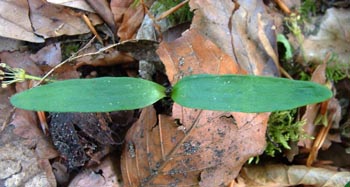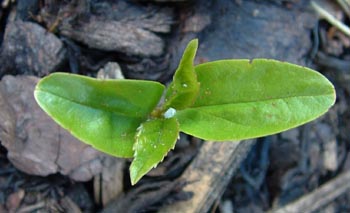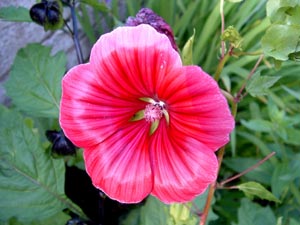May 15th 2005 - Seed success - but is it the right seed?
It rained for over a week after Kim left and the lawn has suddenly gone mad. The combination of warmth and moisture has brought it on in leaps and bounds and itís now looking far greener and less mossy than it was a few weeks ago. No cheeky blighter has described it as Ďruggedí again, which is good. ĎRuggedí indeed.
The legacy of the councilís late cutting of the verges last year is still with us. Whilst the roadsides did look undeniably cheerful last spring, covered as they were with bright yellow dandelions, the plants went to seed very fast and a great many of these then wafted over the wall to settle on the garden here, and no doubt every garden along this road, where they germinated with great success, both in the lawn and the beds. I'm making a point of digging them out whenever I see them, but there are so many that some get missed, until a huge pompon is noticed tucked away in a corner, already gone to seed. Dandelions are all very well in meadows but in our fertile garden soils they are such efficient plants that they can quickly swamp out other plants. The wide rosettes of leaves cut out light and water while the deep tap root takes in a lot of water. They're definitely in the 'wants to take over the world' category and they have to go.
"Iíve pulled out what feels like hundreds (but is probably only dozens) of ash seedlings"
The gales of last autumn also blew in tree seeds and Iíve pulled out what feels like hundreds (but is probably only dozens) of ash seedlings. At first glance, they look a bit like Sycamore seedlings but the seed leaves are a lighter, brighter green and are also shorter and more rounded. The true leaves are noticeably different in not being lobed, as are Sycamoreís, but oval. They pull up easily enough, mind you, and have the advantage of not re-growing from root fragments.

Sycamore seedling

Ash seedling
Now that the other mystery seedlings in the beds are getting bigger and putting out true leaves, I can start to identify them. Whilst there are some that Iím pleased to see, such as Eryngium alpinum, Verbena bonariensis and Rudbeckias, there is a lot there that will unfortunately have to come out. I thought that the birds had taken all the Pyracantha seeds but dozens have germinated at the base of the plants, probably deposited by birds after eating the berries. I canít bring myself to throw them all out and will pot some up till I can think of something else to do with them.
"...as often as I hoe it over, within days itís been trodden quite flat again by tiny avian feet"
Several of the blue-flowered Eryngiums can be left in situ to form larger clumps, but some of them can go at the back of the garden in an area thatís mainly been left for the birds to use. I've never really made a decision on what to do with this bit of garden and it tends to change from one year to the next. Plants that Iím not sure about go in that spot. There is a bit of bare soil there and, as often as I hoe it over, within days itís been trodden quite flat again by tiny avian feet. You wouldnít think that bird foot-traffic could make such a difference but it really does and they are always in that corner rustling around and pecking about.
In with the Eryngiums can go the two Acanthus spinosus, those which were taken from root cuttings. Theyíre coming on fast now and will hopefully be big enough to fill a couple of gaps soon. So far, thatís pale blue and purple flowers with green-grey foliage. What else?
The Ďwhat elseí will be Lavatera trimestris and Malope trifida, which have similar mallow-shaped flowers, both growing to about 1.5m tall.L. trimestris has a paler pink flower, streaked with off-white, while M. trifida is a hot pink, and both have mid-green foliage. These can join the Acanthus and Eryngium, not because I think this combination is especially desirable (though we may be surprised, you never know) but because there were a lot of old Lavatera and Malope seeds left over this spring and I planted them all to see what would happen. The seeds had been sitting for two years, sealed in paper envelopes in a drawer next to my desk. I didnít think so many would germinate, but nearly all of them did. Serves me right, doesnít it.

Malope trifida
"...a bold drift of pinks, blues and pale purples against a background of grey-green and mid-green foliage"
Anyway, thatís what weíre having Ė a bold drift of pinks, blues and pale purples against a background of grey-green and mid-green foliage. To lift the colour mix, some tall white flowered Nicotiana sylvestris can go in too. Planted closer to the apple tree, they should do well in the dappled light and will give off their spicy perfume in the evening. If not N. sylvestris then white-flowered Eremurus robustus, which is attractive to bees. The birds should approve. There will be plenty of cover for them there and, in the autumn, the seed-eaters can go about the old flower heads and clean them out. The flowers will attract insects, so they should approve as well. Good, thatís sorted then.
© Copyright Miranda Hodgson 2005